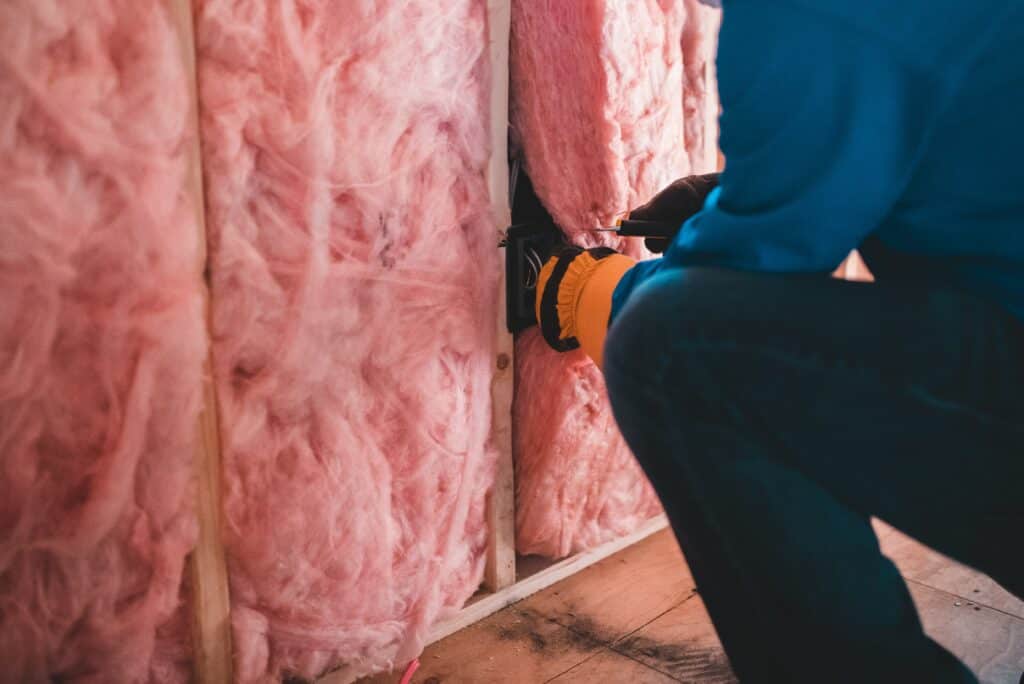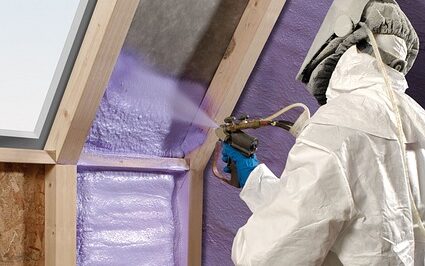Introduction – Best Types Of Insulation For Home
We covered the background of why insulation is good for carbon reduction. Here we’ll cover three topics: R-values to measure the degree of insulation, what things in the home can be insulated and what is the performance of different types. These are the “simple” types of insulation for a home and you won’t be approaching the “passive house” level of performance.

The R-value Measures Insulating Power And Affects Your Heating Costs
The R-value is the insulating power. It is also called “thermal resistivity”, given in per area units. The greater the R-value, the greater “resistance” to heat passing through. To get the amount of heat conducted, you’ll need to invert the R-value. The inversion of R-value, basically dividing one by R-value, gives the conductance U. So for example, if the R-value is 4, then the conductance U is 0.25. The U-value is given in these units: W/(°C⋅m2). This is watts per degree Celsius per square meter.
A large surface has greater heat flux, so U is appropriately given in terms of per unit area. To get the total thermal resistivity you need to multiple U by the area of the surface. In the case of the house, a surface is like a wall, or a roof, or a floor.
The R-value And U-value Are Related By A Simple Mathematical Inversion
The U value also varies with temperature differences. If the outside and inside are the same temperature, there’ll be no heat transferring. This is, interestingly, a restatement of the second law of thermodynamics. In my experience this seems to be in degrees Celsius. If you want to use Fahrenheit, you’ll need to convert it. Multiple the difference in Fahrenheit by 5/9 to get the difference in Celsius, i.e. 

Use The U-value To Calculate The Thermal Loss
In sum then, the total thermal loss is U * 
Doubling The R-value From 2 To 4 Changes Heat Loss By 1000 Watts
Let’s approximate very roughly a boxy house that has 2 levels of 2 meters tall each. And each of its walls has a length of 10 meters. Then the four walls, plus the flat roof, will be 80 square meters + 100 square meters. This is 180 square meters of surface through which heat is lost. We assume the ground is a negligible source of heat escape. With an R-value of 2, the loss is 0.5 Watts x 24 x 180 = 2160 Watts. With an R-value of 4, the loss is cut in half to 1080 Watts.
Therefore, you can see by doubling the R-value, you massively cut heat loss by 1000 Watts! Over a period of 24 hours, that translates to 24 kWh or 90,000 BTU.
Another way to increase insulation is to increase the thickness. R-values are measured on a per square inch thickness basis. As you increase the layering, the insulating gets better.
Attic, Roofs, Walls, Floors
These parts of the house can be insulated with fiberglass batting or spray foam or rigid foam. There are also special insulating paints that can be used on walls.
Fiberglass insulation is the most common type of “filler” insulation. It is made from recycled glass and sand. It is available in rolls or batts and can be installed in walls, ceilings, and floors. The R-value of is 2.4 to 4.0 per inch. Most homes use this type.
Cellulose insulation is made from recycled paper products. It is available in rolls or batts and can be installed in walls, ceilings, and floors. The R-value is 3.0 to 3.8 per inch.
Spray foam insulation is a type of insulation that is sprayed onto walls, ceilings, and floors. It expands and forms a barrier that helps keep heat in or out of a home. The R-value is 3.0 to 7.0 per inch.
Rigid foam insulation is a type of insulation that comes in boards or panels. It can be used on walls, ceilings, and floors. The r-value is 3.5 to 8.0 per inch.
Doors And Windows
These parts of the house can be insulated with weather-stripping or caulk. There’s less options here though I don’t see why we can’t have improved insulated doors. Windows certainly if you get double, triple glazing, that will up the insulation. According to a window manufacturer Jeld-Wen, the U-value of double vs triple is 1.5 vs 1.0. That’s a modest 30% reduction going from double to triple glaze.
What Is Weather Stripping For Insulation
Weather stripping is a process in which the gaps around doors and windows are filled in order to prevent drafts and air leaks.
In order to install weather stripping, you will first need to clean the surface around the door or window. Next, you will need to measure the area in order to cut the weather stripping to size. Once the weather stripping is cut to size, you will need to peel off the adhesive backing and apply it to the door or window.
Weather stripping can last for many years, but it may need to be replaced sooner if it is exposed to sunlight or extreme temperatures. How much does weather stripping save on heating costs? Weather stripping can save you up to 10% on your heating costs.
What Is Caulk For Insulation?
Caulk for insulation is a type of sealant that helps to fill in gaps and cracks in order to prevent heat from escaping. This can be especially useful in older homes that have less insulation.
To apply caulk, first clean the surface around the gap or crack. Then, cut the tip of the caulk tube at a 45 degree angle. Next, insert the tube of caulk into a caulk gun. Finally, squeeze the trigger of the caulk gun to apply the caulk.
Caulk can last for many years, but it will eventually need to be replaced. Caulking can save you money on your heating bills by preventing heat from escaping through gaps and cracks.
Best Insulation?
Think of a case in which you get very expensive insulation with high r-values? Does it make sense? If you feel like you can’t answer the question, that’s because you can’t! Ask yourself whether you the very expensive type. If you live in a cold climate, and your house loses heat quickly, then yes. This is also true if you live somewhere warm and the house heats up quickly. Insulation works both ways: traps in warm air, traps in cold air.

One way to estimate whether your house needs an upgrade in being sealed is to compare your winter heating bill against houses of comparable size. If you’re bill is higher, then there’s a good chance your house is losing more heat than it should.
What about Insulating Paint?
Bob Vila’s website has covered this and concluded that insulating paint has never been tested on large scale. The website also doesn’t recommend it based on anecdote. From a physics point of view, it’s hard to imagine enough “thermal mass” in a thin layer of paint. Thermal mass is what makes it hard for heat or cold to cross a layer of insulation. Paint just doesn’t have any thermal mass so it can’t do a good job insulating. The only kind of insulation it might provide is reflecting radiant energy back into the house.
